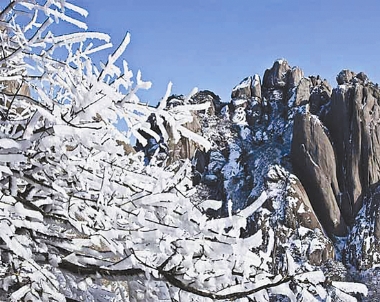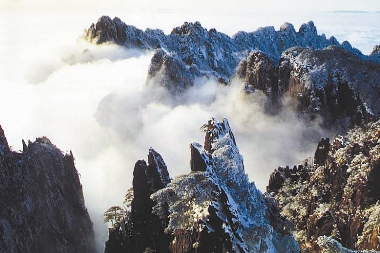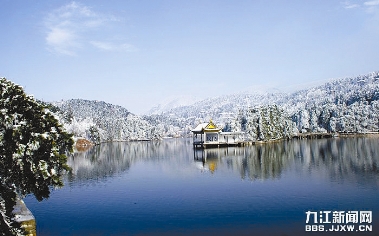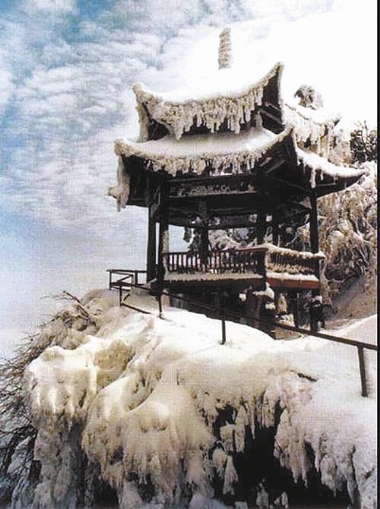



Emei Mountain Emei Mountain’s admission fee is 90 yuan in winter, 60 yuan cheaper than in peak seasons. A cable car return ticket is only 50 yuan. Emei Mountain, to the southwest of Leshan City in Sichuan Province, is one of four celebrated Buddhist mountains in China. The mist-shrouded peaks, forested slopes, Buddhist temples, well-worn paths and winding stone steps have drawn countless pilgrims over the centuries. In winter, sunrises, cloud seas, the Buddha halo and sacred lamp are the four spectacles to be viewed at the Golden Summit at 3,077 meters above sea level. There is a hot spring theme park called Happy Valley. The ski resort in Leidongping of the mountain provided a full range of snow sports accessories for skiing and dog sledding. In winter, the best time to view the sunrise is at 7 a.m. The cloud sea often appears between 9 a.m. and 10 a.m. and 3 to 4 p.m. You could also try your luck in spotting the Buddha halo. Transport: Fly or take a train to Chengdu City. Take a bus at the New South Gate Travel Bus Station to Emei Mountain. It takes about 90 minutes. Delicacies: Rice cakes wrapped in leaves, Tofu pudding, bacon, spiced duck, vegetarian feast, and hotpot. Lushan Mountain Admission to Lushan Mountain falls from 180 to 135 yuan per person from Dec. 1 and will be free to all tourists in January 2011. Lushan Mountain is a fantastic destination throughout the four seasons. Icicles, frost-covered trees, ice towers and the sound of spring water are unique attractions in winter. The 99 peaks on Lushan Mountain are covered by snow in winter with colorful pavilions part of the scenery. There are more than 600 villas on the mountain, representing world architecture as well as a modern history of China. The Xingzi County Hot Springs, to the south of the Lushan Mountain Scenic Spot, is the biggest radon-rich hot springs in China. The temperature is a constant 72.5 degrees Celsius. It is opposite the Big Hanyang Peak, the highest point on Lushan Mountain and a good place to enjoy mountain scenery and the hot springs. Transport: Fly or take a train to Jiujiang City, then take a bus to the Lushan Mountain Scenic Spot. Delicacies: Stone chicken, stone fish, stone fungus and cloud and mist tea of Lushan Mountain are a must. Mountains are a good choice for a winter travel experience. A world of ice and snow, seas of clouds, memorable hiking and, best of all, cheaper than other peak seasons. Huangshan Mountain The admission fee to Huangshan Mountain falls from 230 to 150 yuan in winter. Cable car tickets are 65 yuan one way. Huangshan Mountain in Anhui Province is one of the Five Sacred Mountains in China. It has been included in UNESCO’s World Cultural and Natural Heritage List and has been a destination for tourists and inspired artists and poets for centuries. Winter is the best season to visit. Snow-covered trees, seas of clouds and hot springs are winter attractions on Huangshan Mountain. Tiandu, Lianhua and Jiulong peaks present spectacular, snow-covered landscapes. Huangshan Mountain is famous for its frost-covered trees, particularly ancient twisted pine trees in winter. The cloud sea usually appears after rain or snow at an altitude of about 1,000 meters. The temperature in winter could fall to minus 10 degrees Celsius. Hotels on the mountain provide down-filled or cotton-padded overcoats. Hikers are advised to take an alpenstock. Transport: Fly or take a train to Huangshan City. Take a bus or taxi to the Huangshan Mountain Scenic Spot. Delicacies: Anhui cuisine such as stewed pigeon, stewed turtle soup, smoked chicken, mountain bamboo shoots are worth a taste. | 
